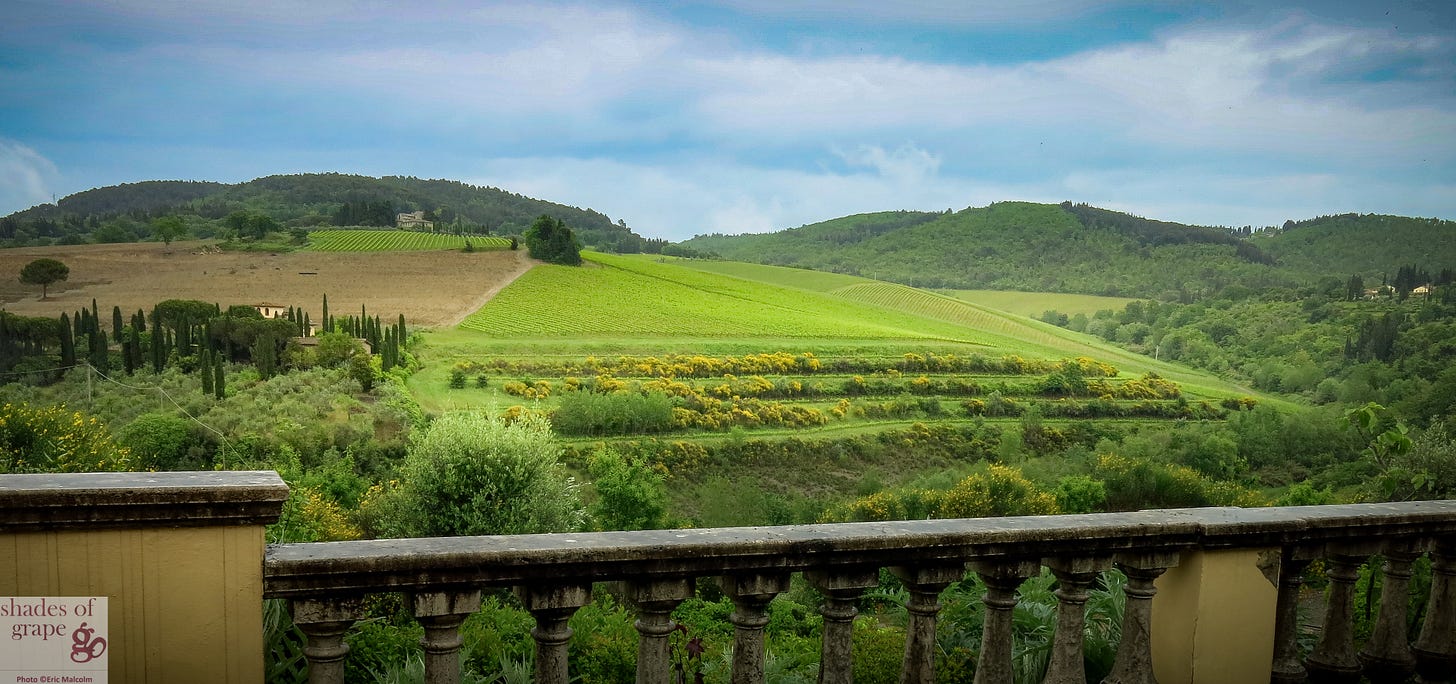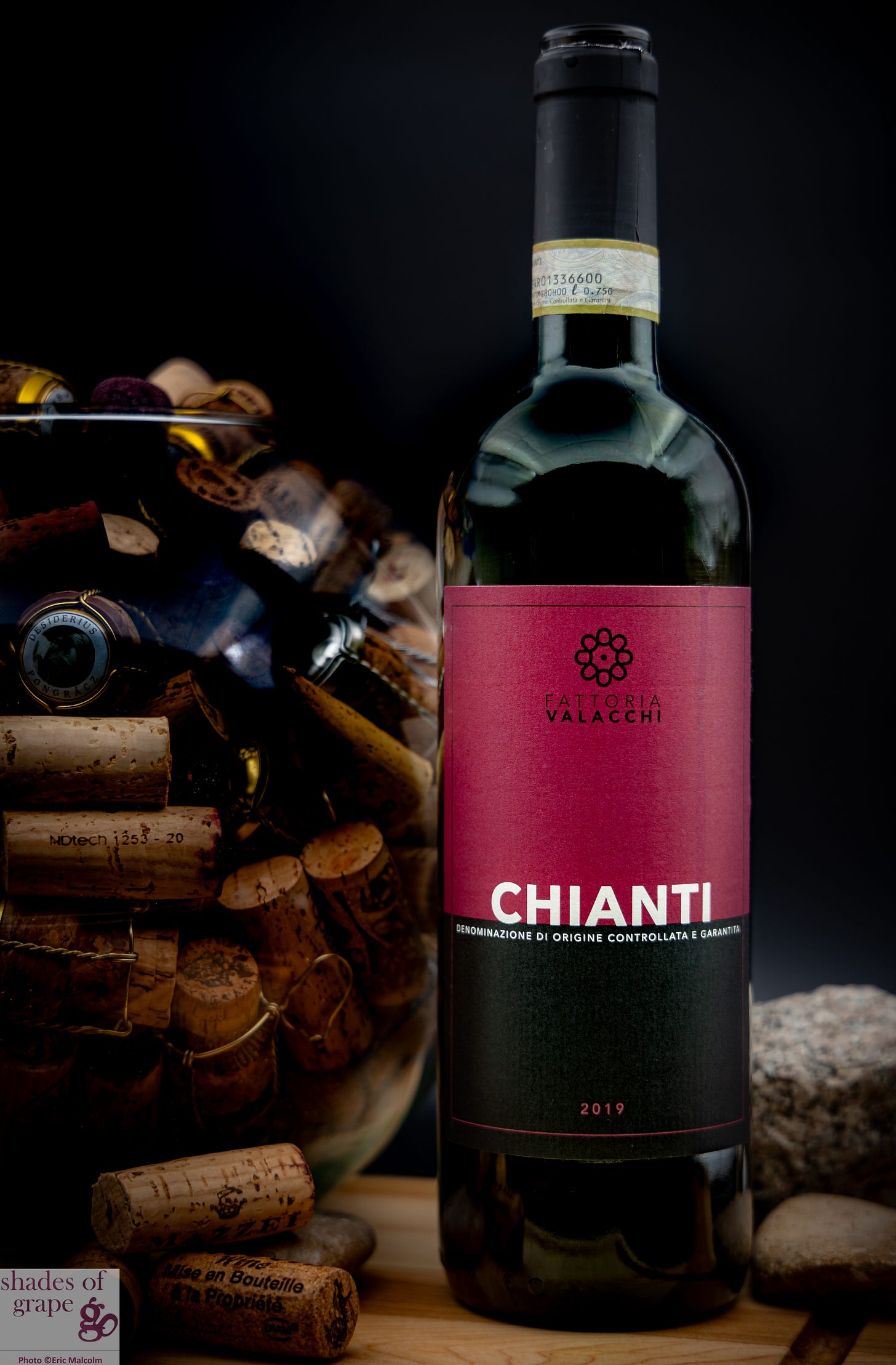Chianti vs. Chianti Classico: Sangiovese Vineyard Secrets
– from Etruscan origins to Medici legacy
I spent a lot of time in Tuscany last year. One of my Diploma WSET course sessions was in Tuscany and included visits to several of its wine sub-regions. One of those is Chianti.
The main grape of the region is Sangiovese. It has ancient origins dating back to the Etruscan period (8th to 3rd century B.C.). Incredibly, these wines were exported to southern Italy and Gaul (essentially France now).
The grape has many clones with a large quality variability. Even in the 16th century, 2 main “families” of clones were identified: Piccolo and Grosso, the latter perceived as superior. Sangiovese is known for high acidity and tannins that need to be managed in the vineyard and winery to ensure quality and balanced wines. Its wines also have a light color because the grape has low color pigment concentration.
In the 60’s, the government was promoting high yielding clones of Sangiovese, promoting quantity versus quality, resulting in the production of inferior wines. Tuscany became known as a region with poor quality wine. This led to the Super Tuscan development, which is another story altogether, and led the region to up its game to focus on quality.
A project named “Chianti Classico 2000” studied various clones and made a recommendation of 7 quality clones which have been widely embraced by growers. These have smaller thicker-skinned grapes. Since color and flavor come from the skins, these clones produce more flavorful wines with a deeper color.
In the Middle Ages, the hills between Florence and Siena were called the Chianti Mountains with 1398 documents referring to the region’s wine as Chianti (eventually renamed Chianti Classico). The Medicis attempted to set up the first wine sub-region of its kind in 1716 when Cosimo III, Grand Duke of Tuscany set regulations and geographical boundaries to reduce fraud and guarantee wine authenticity.
OK… pause please – who are the Medicis?
The House of Medici was an Italian banking family that ruled Florence for most of the 15th to early 18th century. They married into European royal families, and produced four popes (and we know how much the royals and popes liked wine!)
So, the Medici’s understood money AND wine!
However, the Medicis’ understanding of the link between wine and place was not respected (or simply ignored) in the 20th century. When producers could not keep up with the demand, they started to produce wine outside the historical boundaries! These vineyards did not have the same soil or elevation of the official Chianti area. Sangiovese produces better quality wines at elevations of 200 to 550 meters, does quite well on clay, and grows best in soils with proper drainage.
To preserve the quality and reputation of the original historic Chianti region, a consortium was founded. They adopted the black rooster as their symbol. This symbol had been used by the original wine region in 1384 and was later recognized by the Medicis. To their dismay, in 1930s the Chianti borders were officially expanded significantly. The original “Cosimo III” hilly region became known as Chianti Classico.
So, you talk quality differences between Chianti and Chianti Classico sub-regions. How is this manifested in the glass?
Typically, Chianti has low to medium flavor intensity and medium body, ranges in quality from acceptable to very good, and is less expensive than the typically very good to outstanding quality Chianti Classico. Chianti Classico wines have more structure and body than Chianti and medium or higher flavor intensity. Chianti has to be a minimum of 70% Sangiovese, and Chianti Classico 80%, although the latter’s wines are in practice typically made with a minimum of 90% Sangiovese.
In 1872, Barone Bettino Ricasoli’s research resulted in a recommendation to blend Chianti wines to soften their harsh tannins and acidity. But this is no longer necessary due to the increase in knowledge of modern winemaking! In fact in 1996, the regulations in Chianti Classico were amended, allowing 100% Sangiovese wines.
Got it, so avoid the Chianti … who wants an acceptable wine!
There are Chiantis that are very good. Attention to the grape growing and winemaking, as always, makes a big difference. Also, remember that site selection is important. What if a wine is very close to Chianti Classico demarcation with similar soils and elevation? There would still be cooler nights that lengthen the growing season, and the soils would provide good drainage and good structure and body. The producer legally many not be able to label it Chianti Classico and boast the black rooster symbol, but it still may be of very good quality due to attention paid by the producer.
Case in point is this post’s featured wine! I remember liking it when the representative sampled it at Cork during one of our Thirsty Thursday afternoon tastings. I remember thinking I would love this wine with pizza! My opinion was reaffirmed several weeks later when we had it chosen for our Cork Wine Blinding Club (where even the staff don’t know the wines!)
Tasting wines blind is always a good way to eliminate biases - in this case, the bias that Chianti wines are only good quality at best. Certainly, if you don’t know differently, it is a better bet to choose a Chianti Classico! But if someone you trust recommends a Chianti or you get a chance to sample one prior to buying, there are some great value wines, such as the Fattoria Valacchi Chianti! The production area is close to the town of Barberino Val d’Elsa, which is actually in the Chianti Classico region. The vineyard from which this wine is made is at 250-300 m elevation (while Chianti Classico is at 200-500 m). This wine is made of 100% Sangiovese which speaks to the producer’s confidence in his grapes.
Fattoria Valacchi Chianti 2019 from Chianti, Tuscany, Italy
Style: Old World Medium Body Red
Varieties: 100% Sangiovese
This balanced wine with moderate tannins has moderately high intensity of sour red cherry, strawberry flavors, with the complexity of cedar, cinnamon, earth, forest floor, and notes of anise.
Best pairings: Pizza! Lasagna, Pasta with Tomato Sauce, Fennel Flavored Sausage, Burgers, Roasted Vegetables (eggplant, bell peppers & zucchini), Hard Cheeses: Parmigiano-Reggiano, Pecorino, Aged Gouda,
Serving Temperature: 18 degrees Celsius
Price: $24 (incl. Shades of Grape 15% discount & 5% gst)
Serving Tips: No need to decant.
I have compiled all my wine recommendations in one place. I will do my best to keep this up to date. I also include the link(s) to the article in which the wine was featured.
Like what you are reading? Click on the ❤ to let me know it resonated with you!
SOURCES:
Chianti Classico (2020) History of Chianti Classico - Chianti Classico. https://www.chianticlassico.com/en/consortium/history-of-chianti-classico/.
Chianti Classico (2024) Chianti Classico - Il primo territorio di vino. https://www.chianticlassico.com/en/.
'chianti classico' » Italian Wine Central (no date). https://italianwinecentral.com/?s=chianti+classico.
Chianti DOCG » Italian Wine Central (no date). https://italianwinecentral.com/denomination/chianti-docg/.
Chianti PDO (no date). https://agriculture.ec.europa.eu/farming/geographical-indications-and-quality-schemes/geographical-indications-food-and-drink/chianti-pdo_en.
Fattoria Valacchi | Resort & Winery (no date). https://fattoriavalacchi.it/en/home-inglese/.
Gianmarco and Gianmarco (2021) Types of Chianti - Consorzio Vino Chianti. https://www.consorziovinochianti.it/types-of-chianti/?lang=en.
Medici family | Definition, Members, History, Tree, & Facts (2024). https://www.britannica.com/topic/Medici-family/The-grand-dukes-of-Tuscany.
Mowery, L. (2019) A Beginner’s Guide to Chianti and Chianti Classico. https://www.wineenthusiast.com/basics/beginners-guide-chianti-chianti-classico/.
Wikipedia contributors (2024) House of Medici. https://en.wikipedia.org/wiki/House_of_Medici#:~:text=The%20House%20of%20Medici%20(English,half%20of%20the%2015th%20century.
Robinson, J. (2015) The oxford companion to wine. 4th rev. ed. Corby: Oxford University Press.
Wine & Spirit Education Trust (2021) D3: Wines of the World - An accompaniment to the WSET Level 4 Diploma in Wines. Version 1.2. London: Wine & Spirit Education Trust.






